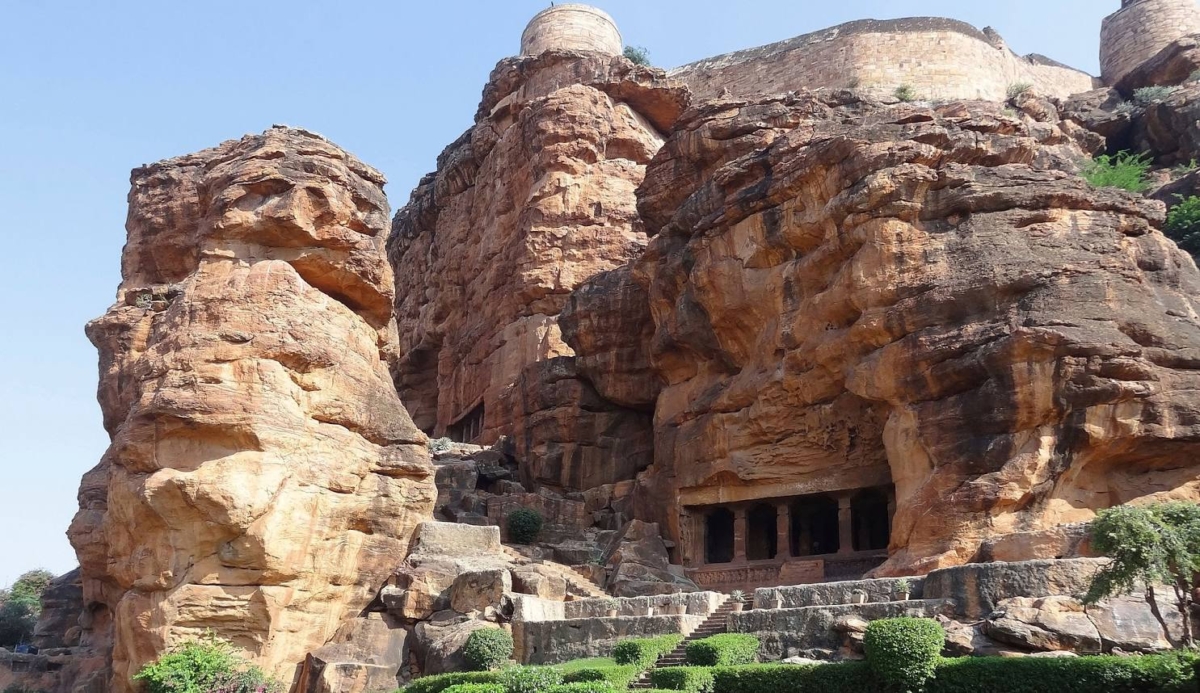Table of Contents
ToggleBadami The Badami Cave Temples, located in Karnataka, India, are a remarkable example of early Indian rock-cut architecture and a testament to the artistic and architectural prowess of the Badami Chalukyas, who ruled the region between the 6th and 8th centuries AD. This UNESCO Recognised World Heritage temple complex comprises four main caves, each dedicated to different deities and religious traditions, including Hinduism and Jainism. Carved into the red sandstone cliffs overlooking Agastya Lake, these caves feature intricate reliefs, sculptures, and inscriptions that reflect the religious, cultural, and political history of the era. Notable highlights include depictions of Hindu gods such as Shiva, Vishnu, and their various avatars, as well as Jain Tirthankaras. The caves also showcase a blend of architectural styles, with influences from both northern and southern India. The Badami Cave Temples are not only a significant heritage site but also an enduring symbol of the region’s rich history and cultural legacy.
Historical Background
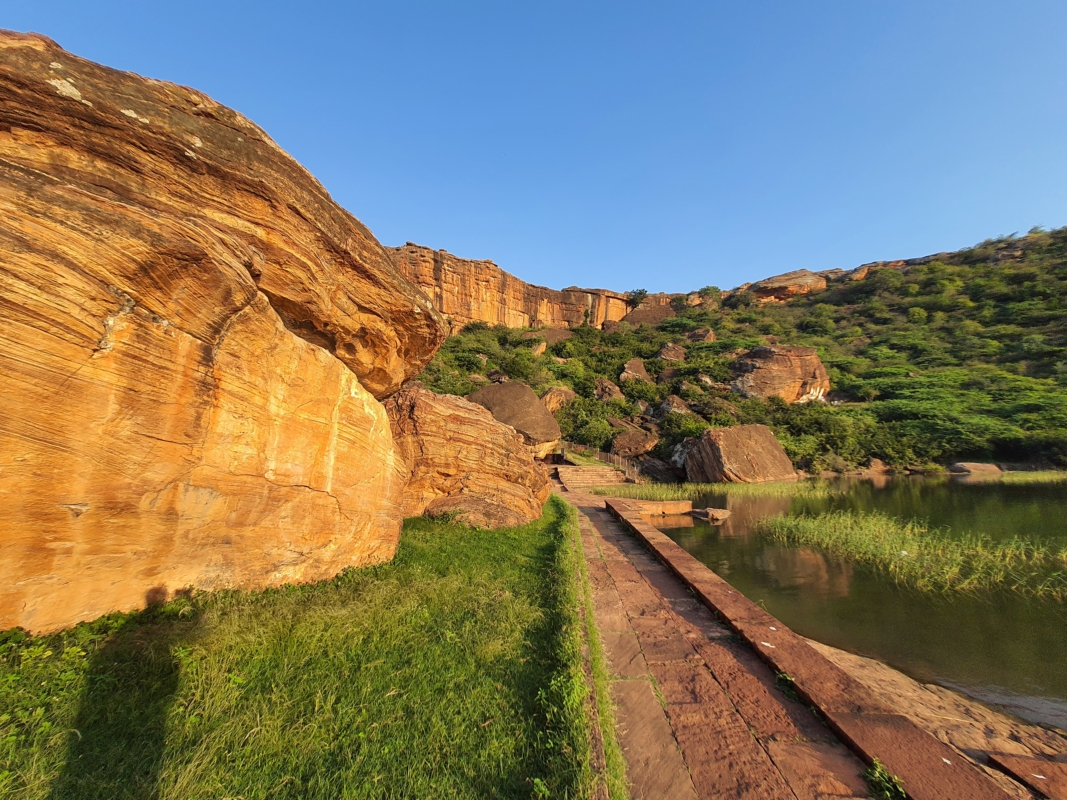
The history of the Badami Cave Temples is deeply intertwined with the rise of the Chalukya dynasty, which established its capital in Badami (formerly known as Vatapi) during the 6th century AD. Founded by Pulakeshin I, the Badami Chalukyas were instrumental in shaping the region’s political and cultural landscape. The construction of the caves is attributed to his successors, primarily Pulakeshin II, under whose reign the Chalukyan empire reached its zenith. The Badami Cave Temples were carved between the 6th and 8th centuries AD, reflecting the evolving artistic and religious ideologies of the period.
The creation of these caves marked the beginning of a golden age in Karnataka’s history, influencing subsequent temple architecture across the Deccan region. The legacy of the Chalukyas, preserved within the Badami Cave Temples, remains a significant chapter in the cultural history of India.
Architectural and Artistic Exploration of the Caves
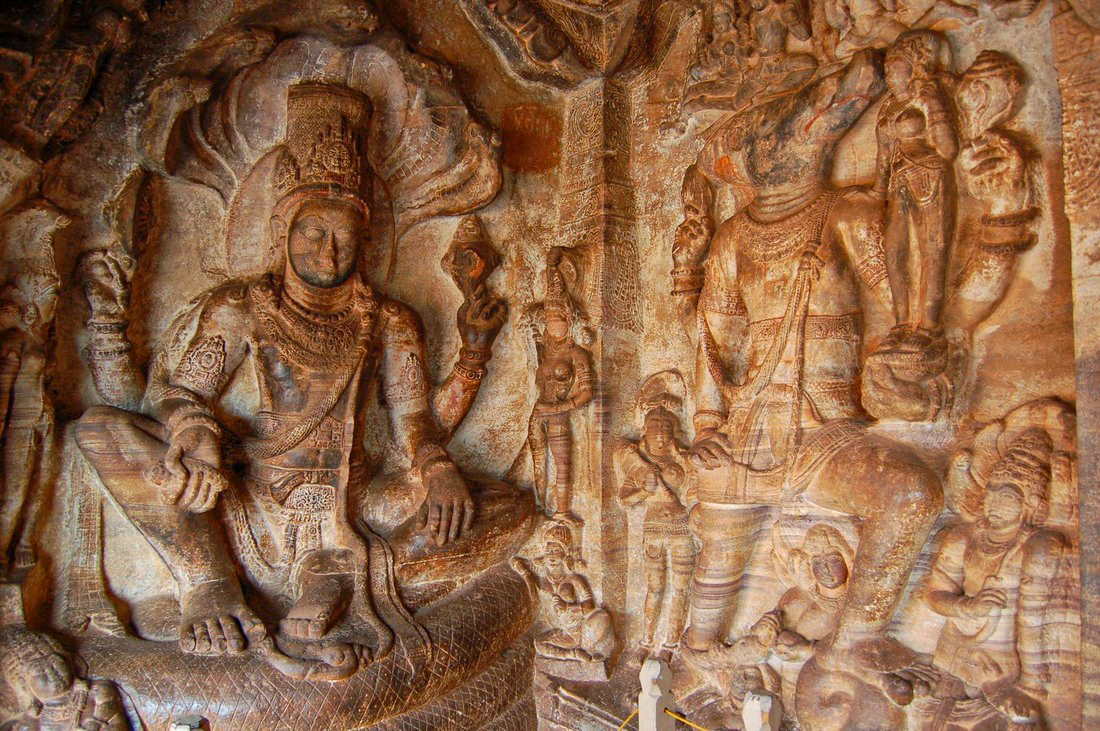
The architectural brilliance of the Badami Cave Temples lies in their integration of religious symbolism, artistic precision, and advanced rock-cutting techniques, all executed on the rugged red sandstone cliffs. Each of the four caves is a monolithic rock-cut structure, showcasing intricate carvings, stunning sculptures, and elaborately designed pillars. The caves reflect a blend of Dravidian and Nagara architectural styles, underscoring the Chalukyas’ role as cultural bridges between northern and southern India.
Cave 1,
Dedicated to Lord Shiva, the Cave 1 of the Badami Cave Temples, is the oldest among the four and sets the tone for the series. The entrance is flanked by intricately carved Dwarapalas (gatekeepers), leading into a hall supported by robust pillars adorned with ornate designs.
The central highlight is the imposing figure of Nataraja with 18 arms, depicted performing various dance mudras. The ceiling features concentric designs with floral motifs, while the walls bear friezes of Shiva’s attendants and mythological creatures. The dynamic energy captured in the carvings contrasts with the stability of the architecture, creating a visually compelling narrative of divine power.
Cave 2 is smaller but equally captivating, dedicated to Lord Vishnu. The cave is distinguished by its portrayal of Vishnu’s avatars, notably the Trivikrama form, where he is shown extending his leg in a cosmic stride. The walls and ceilings are adorned with detailed carvings of Garuda (Vishnu’s mount), celestial nymphs, and various deities. The pillars have lotus medallions, and each pillar’s capital features sculptures of lions and mythical creatures. The symmetry and proportionality of these carvings, combined with the smooth, polished surfaces, highlight the technical mastery of the Chalukyan artisans.
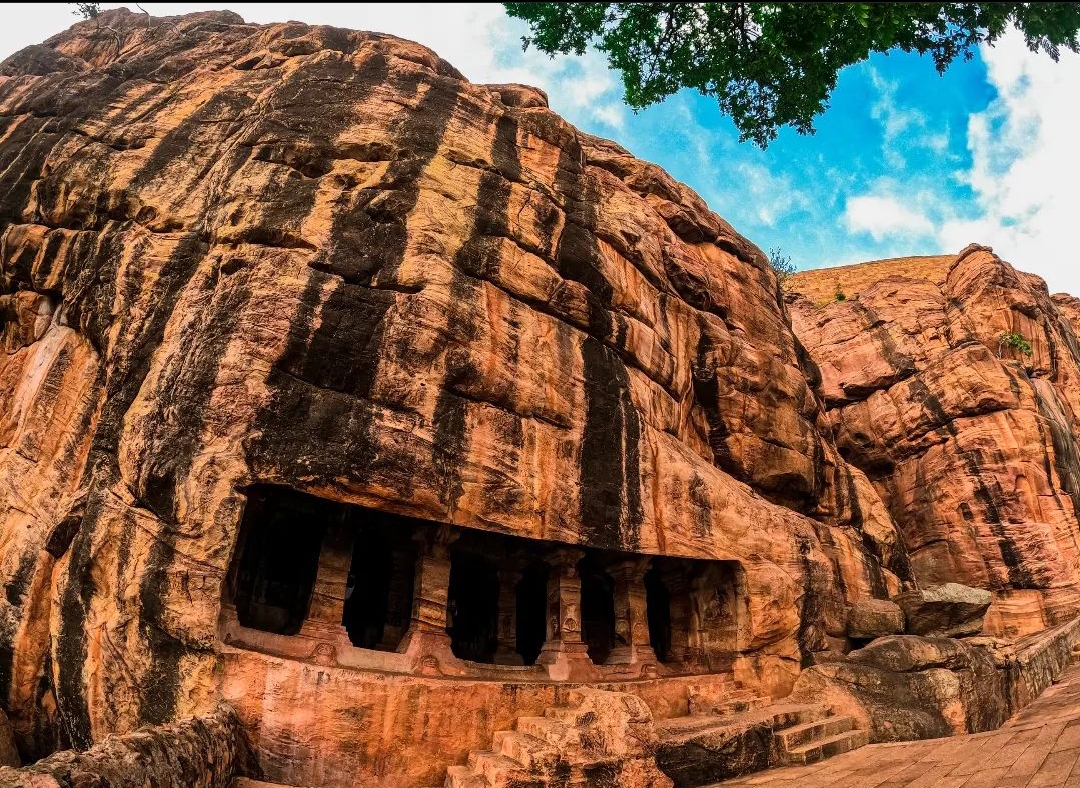
Cave 3 is the largest and most elaborate, demonstrating an advanced stage of architectural sophistication. This cave is a vast hall with intricately carved pillars featuring yali (mythical lion-like creatures) and floral motifs. The cave’s walls are adorned with stunning reliefs of Vishnu in different forms—seated on Adisesha, as Varaha lifting the Earth, and as Narasimha tearing through Hiranyakashipu. The ceiling showcases elaborate mandalas, with concentric circles featuring gods and goddesses in dynamic poses. The cave’s grand scale and attention to detail make it a masterpiece of early Chalukyan architecture.
Cave 4 is the smallest and most distinct, being dedicated to Jainism. Architecturally, it is simpler, with more focus on symmetry and serene expressions in the sculptures. The cave features seated and standing figures of Jain Tirthankaras, including a large sculpture of Mahavira in a meditative posture. The cave walls are adorned with depictions of Jain monks and attendants, reflecting the spiritual discipline of Jain philosophy. The restrained ornamentation contrasts with the flamboyant carvings of the Hindu caves, creating a tranquil ambiance.
The architectural layout of the caves is a marvel in itself, with each cave aligned in a sequence that offers a progressive exploration of religious themes, from Shaivism to Vaishnavism and finally Jainism. The entrances are decorated with Makara Toranas (arched gateways) and intricately carved lintels, showcasing mythical beings and divine symbols. The caves are also notable for their use of square and octagonal pillars, which are richly carved with geometric patterns and narrative scenes.
The sculptural reliefs, ranging from large bas-reliefs of deities to finely etched details on pillars and doorways, display a high degree of craftsmanship. The interplay of light and shadow on the carvings creates a dynamic visual effect, bringing the figures to life. The use of perspective, anatomical precision, and expressive facial features in the sculptures indicate a sophisticated understanding of both artistic and religious aesthetics.
Overall, the Badami Cave Temples stand as a monumental achievement in early Indian architecture, blending form and function with spiritual expression. Their design exemplifies the Chalukyan ambition to create spaces that are not only places of worship but also masterpieces of enduring artistic value.
Cultural and Religious Significance
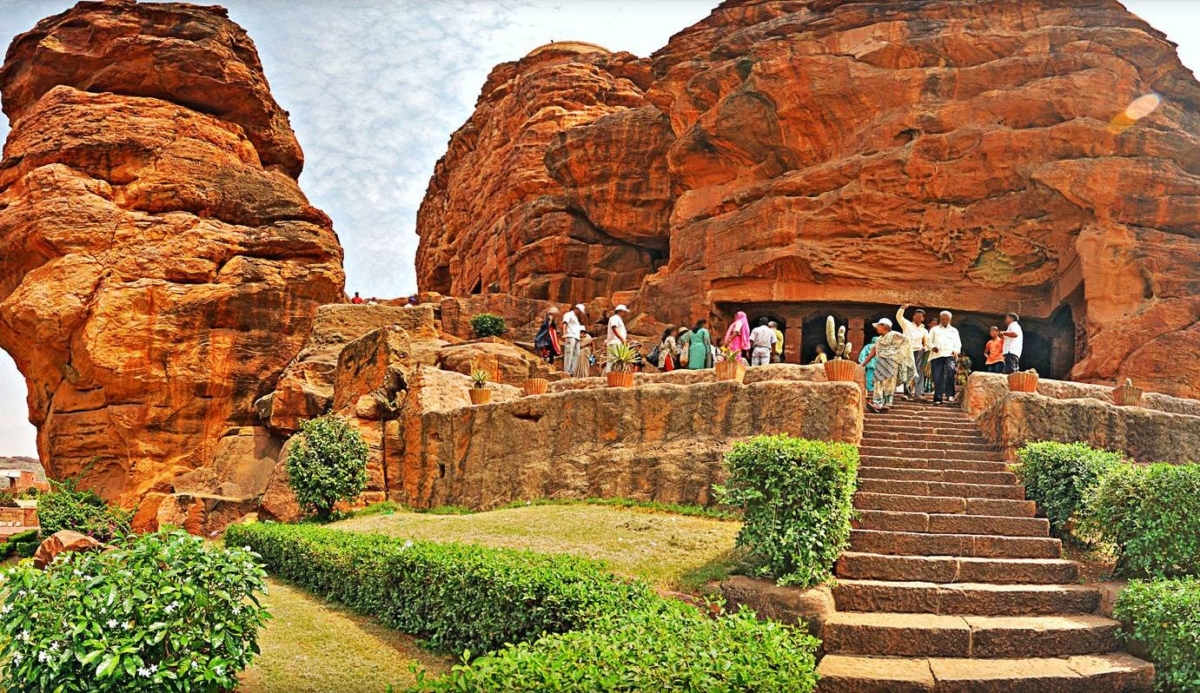
The Badami Cave Temples hold profound cultural and religious importance, serving as spiritual hubs for Hinduism and Jainism, and as symbols of the region’s rich religious history. These caves are emblematic of the Chalukya dynasty’s role in the propagation of religious traditions, blending the sacred philosophies of Shaivism, Vaishnavism, and Jainism. The temples reflect a harmonious coexistence of different faiths, highlighting the inclusivity and pluralistic values of the era.
The caves’ architecture and art emphasize the spiritual themes central to Hindu and Jain thought, using intricate iconography and symbolism to convey religious narratives. The presence of dynamic depictions of Shiva, Vishnu, and Jain Tirthankaras reflects the temples’ roles as spaces of worship, pilgrimage, and spiritual learning. Rituals and religious ceremonies are still held in these caves, connecting modern devotees with centuries-old traditions.
The celebration of major festivals, like Maha Shivaratri, draws pilgrims from across the region, making the caves a focal point for communal gatherings and religious observance. These festivals highlight the continuing relevance of the site, where spirituality intersects with cultural identity.
Additionally, the Badami Cave Temples played a significant role in the cultural diffusion of Dravidian traditions and religious iconography, influencing temple architecture and sculpture in subsequent eras. The rich artistic motifs found in the caves inspired similar styles in neighboring regions like Aihole and Pattadakal, establishing a legacy of artistic continuity.
The presence of Jain imagery, particularly in Cave 4, signifies the broad acceptance of diverse spiritual paths during the Chalukyan period. The intricate sculptures of Tirthankaras underscore the Jain emphasis on asceticism, non-violence, and spiritual liberation. This coexistence of Hindu and Jain religious themes within a single site illustrates the region’s syncretic culture.
The caves are not only architectural marvels but also repositories of historical narratives, offering insights into the religious and socio-political dynamics of the Chalukya period. They symbolize a cultural renaissance in South India, where art, religion, and governance intertwined to create lasting heritage.
In essence, the Badami Cave Temples stand as a testament to the religious devotion and artistic innovation of the era, serving as a bridge between the past and the present. Their enduring significance lies in their role as both sacred sites and cultural landmarks, reflecting the spiritual depth and artistic genius of early Indian civilization.
Visitor Experience
Visiting the Badami Cave Temples offers a journey through history, art, and spirituality, set against the dramatic backdrop of the rugged sandstone cliffs. The experience begins with the ascent up a series of stone steps that lead to the ancient caves, each offering its own unique architectural and artistic treasures.
How to Reach Badami Cave Temples:
By Air
- Nearest Major Airport:
- Hubballi Airport (HBX): Located approximately 100 kilometers from Badami.
- Bengaluru Airport (BLR): Around 500 kilometers away, with more frequent flight options.
- From Hubballi Airport:
- Taxi: Hire a taxi directly from the airport to Badami. The journey takes about 2-3 hours.
- Bus: Take a bus from Hubballi to Badami. Buses are available at regular intervals, and the journey also takes around 2-3 hours.
- From Bengaluru Airport:
- Taxi: Direct taxis can be hired, but it’s a long drive of about 8-10 hours.
- Train: Opt for a train journey from Bengaluru to Badami, which may be more convenient.
By Train
- Nearest Railway Station:
- Badami Railway Station (BDM): Located within the town, providing easy access to the cave temples.
- Train Services:
- From Bengaluru: Trains such as the Hubballi Express and other express services connect Bengaluru to Badami. The journey takes approximately 9-10 hours.
- From Hyderabad: Regular trains from Hyderabad to Badami are available, with a travel time of around 8-9 hours.
- From the Railway Station:
- Local Transport: Auto-rickshaws and taxis are available at the railway station to take you to the cave temples and other local attractions.
By Road
- From Bengaluru:
- Driving: Badami is about 500 kilometers from Bengaluru. The drive takes around 8-10 hours via National Highway 65 (NH65). The route is well-marked and passes through picturesque landscapes.
- Bus: Several private and state-run buses operate from Bengaluru to Badami. Options include luxury, semi-sleeper, and sleeper buses. The journey takes about 8-10 hours.
- From Hubballi:
- Driving: A drive from Hubballi to Badami takes approximately 2-3 hours. The route is straightforward and well-connected.
- Bus: Buses from Hubballi to Badami are frequent and offer a comfortable travel option.
- Local Transport:
- Auto-rickshaws: Widely available in Badami for local travel and sightseeing.
- Taxis: Can be hired for customized tours of the caves and nearby attractions.
Best Time to Visit:
The ideal time to explore the caves is during the cooler months, from October to March, when the weather is pleasant. Visiting during early mornings or late afternoons allows one to avoid the midday heat and enjoy the play of light and shadows on the carvings.
Nearby Attractions:
Visitors to Badami often combine their trip with excursions to nearby heritage sites:
- Aihole and Pattadakal: Known as the “Cradle of Indian Temple Architecture,” Aihole and Pattadakal are UNESCO World Heritage Sites, located a short drive from Badami.
- Badami Fort: Located atop a cliff overlooking the caves, the fort offers panoramic views of the surrounding landscape and Agastya Lake.
- Agastya Lake: The serene waters of this lake, surrounded by temples and cliffs, provide a picturesque setting for relaxation and photography.
Local Facilities: Badami offers a range of accommodations, from budget lodges to mid-range hotels, catering to different types of travelers. The town also has local eateries serving North Karnataka cuisine, with options for traditional meals and snacks.
Guided Tours: Hiring a local guide can greatly enhance the experience, as they provide in-depth knowledge about the history, mythology, and artistic details of the caves. Guided tours are available at the entrance and can be arranged for individuals or groups.
For photography enthusiasts, the caves present numerous opportunities to capture the stunning rock-cut sculptures and panoramic views. However, visitors should respect any signage or guidelines regarding photography, particularly in areas of religious significance.
Whether you’re an art lover, history enthusiast, or spiritual seeker, the Badami Cave Temples offer a memorable and enriching experience that connects the past with the present, revealing the enduring legacy of India’s architectural and cultural heritage.
Preservation and Conservation
The Badami Cave Temples, despite their age and exposure to natural elements, have largely survived the ravages of time, thanks to continuous efforts at preservation and conservation. However, the site still faces several challenges in maintaining its structural and artistic integrity.
Current State of Preservation: The Archaeological Survey of India (ASI) oversees the conservation of the Badami Cave Temples, ensuring that restoration and maintenance work is carried out periodically. The sandstone, being a relatively soft material, is susceptible to weathering, erosion, and damage from environmental factors such as rain, wind, and temperature fluctuations. Conservation measures have focused on preserving the carvings, stabilizing the rock faces, and preventing further degradation.
Conservation Challenges:
- Weathering and Erosion: The constant exposure to weather conditions leads to gradual erosion, which can blur the fine details of the carvings and sculptures.
- Tourism Impact: The increasing number of tourists, while beneficial for local economies, brings challenges such as littering, inadvertent damage, and the wear and tear of pathways and structures. Managing foot traffic and ensuring responsible tourism practices are crucial for the long-term preservation of the site.
- Vandalism and Graffiti: Despite being a protected heritage site, some areas have faced issues of vandalism and graffiti, which have marred the historical integrity of the temples. The ASI has taken steps to curb these activities, including stricter monitoring and visitor awareness programs.
Preservation Efforts: The ASI regularly conducts structural surveys and restoration projects to address issues such as cracks, erosion, and damage to the sculptures. Protective coatings are sometimes applied to shield delicate carvings from further weathering. Additionally, efforts are being made to improve visitor facilities while ensuring minimal impact on the site’s historical fabric.
The ongoing conservation of the Badami Cave Temples is a delicate balance between preserving the site’s historical and cultural significance and accommodating its role as a popular tourist destination. Continuous awareness, responsible tourism, and advanced conservation techniques are essential in maintaining this architectural marvel for future generations to appreciate and enjoy.
The Badami Cave Temples stand as a testament to the grandeur of early Indian rock-cut architecture and the rich cultural and religious heritage of the Chalukyas. Carved meticulously into the red sandstone cliffs, these caves not only showcase intricate artistry and architectural innovation but also reflect the diverse religious traditions of Hinduism and Jainism that flourished during the 6th to 8th centuries AD.
The temples’ blend of Dravidian and Northern Indian architectural styles, coupled with their impressive carvings and sculptures, make them a remarkable example of ancient craftsmanship and devotion. They continue to attract historians, architects, and tourists, offering a glimpse into the artistic and religious life of the Chalukyan era.
Visiting the Badami Cave Temples provides more than just a historical exploration; it is an opportunity to witness the enduring legacy of a bygone civilization. Travelers are encouraged to explore these ancient marvels, appreciating their historical significance and contributing to their preservation. As we reflect on the cultural heritage of the Chalukyas, the Badami Cave Temples remind us of the timeless nature of art and architecture and the importance of safeguarding these treasures for future generations.

